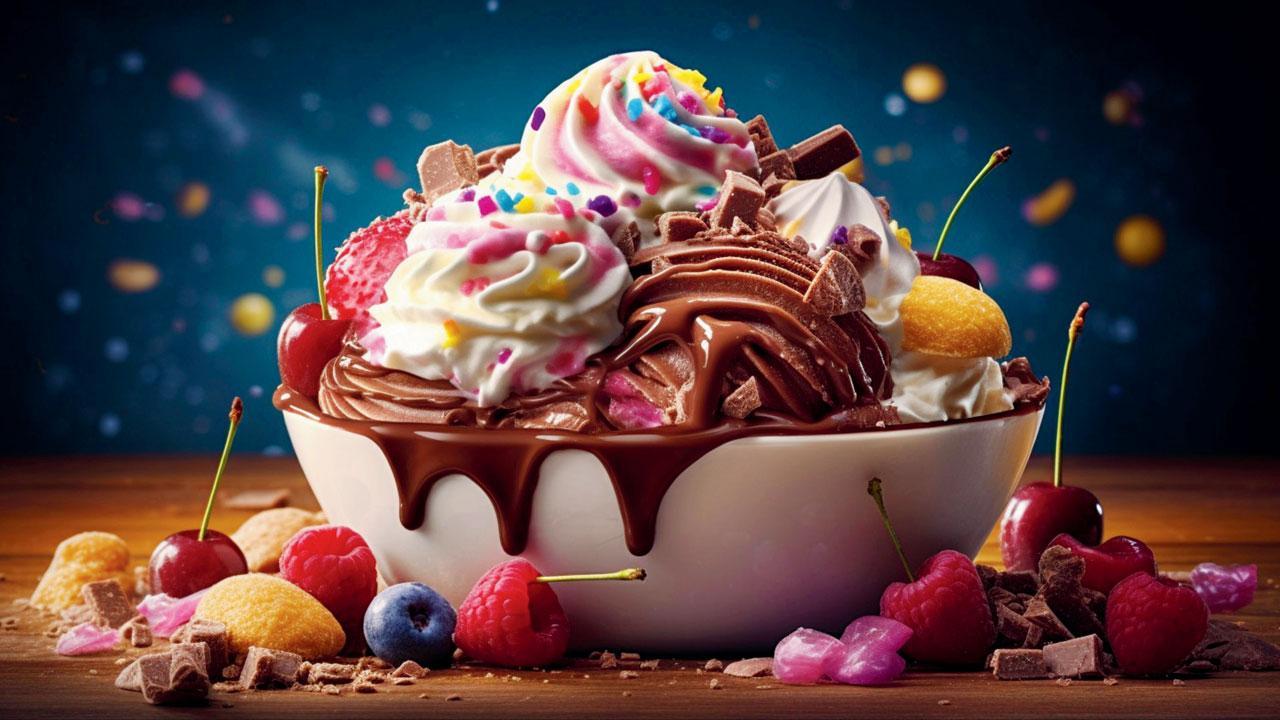There’s a thing about ice cream that scientists hate to talk about. Every study proves that just half a cup a day helps ward off insulin resistance and diabetes

Eating ice cream was 2.5 times more effective than milk in preventing insulin resistance. Illustration by C Y Gopinath using Midjourney
 Please, do help yourself,” said the lady across from me, a Filipina princess with the sensibilities of a hobbit and a shocking history of secret dalliances with food.
Please, do help yourself,” said the lady across from me, a Filipina princess with the sensibilities of a hobbit and a shocking history of secret dalliances with food.
ADVERTISEMENT
The plate in front of her was orgasmic. Lines of golden honey ran from end to end, some 30 or 40 of them, lumping into sinful puddles where the lines ended. On this luxurious bed sat three fantasies, each more seductive than the other. The first was a wedge of cherry crumble an inch or so thick, buttery yellow on top and a teddy-bear brown on its side. A cherry sat red and smug on top of it.
Bigamy was on the menu. Close enough to the cherry crumble to be flirting shamelessly were two utterly lascivious brides-in-waiting, luscious scoops of ice cream flaunting their assets. The vanilla vixen, already with creamy ruffles at waist level, was dotted with cinnamon, elegant and understated, sure that history and glamour were on her side.
But lavender competition was just a nudge away: a golf ball of blueberry ice cream, white smeared with dripping violet, this time sprinkled with toasted almonds. Three real blueberries stood at the plate’s cardinal points, mascots to this gluttonous post-lunch orgy.
“I really couldn’t,” I said. “But oh my god, just look at it!”
“Why couldn’t you?” I was asked.
“Well, so much cream,” I demurred. “And fat. What about sugar? It’s practically inviting insulin resistance.” I laughed awkwardly.
“But you’re not diabetic, are you?”
“Not yet, I suppose,” I said, sorely tempted but determined not to surrender.
“What’s stopping you then?”
I fumbled for a fitting answer. “You know what I mean. I mean, it is ice cream! It’s bad for health. I mean, right?”
But thereby, I believe, hangs a tale of one of nutrition science’s dirty little secrets. It’s the quiet part that you never say out loud.
We call to the witness stand one Andres Ardisson Korat, a Harvard doctoral student studying the relationship between dairy foods and chronic disease. It’s 2018. His data, rigorously collected and analysed, is leading him to an unusual conclusion: among diabetics, eating half a cup of ice cream a day seemed to be associated with a lower risk of developing insulin resistance.
No one liked the conclusion, naturally. Whatever science said, everyone knew that ice cream was one of the sinful baddies of nutrition, a now-and-then indulgence for those who liked living on the edge. It had all the wrong things, never mind if they were organically produced and had practically no carbon footprint: saturated fats, sugar, synthetic flavourings, emulsifiers, god knows what else.
Make it go away, said the department chair, Frank Hu. Dig deeper.
Andres dug deeper but came up again with the same answer: somehow, ice cream was just a great addition to your diet if you were on the road to diabetes or even were a trembling pre-diabetic.
Twenty years earlier, Mark Pereira, as an assistant professor at Harvard Medical School, had been researching the connection between consuming dairy products and obesity and diabetes. Using data from a 1985 study of how heart disease emerged in 5,000 young adults, he found that dairy foods—milk, cheese, cream, yoghurt, with all possible fat levels—seemed to prevent chubby folks from developing insulin resistance.
The study made waves but everyone was uncomfortable with one key finding: ice cream was 2.5 times more effective than milk in preventing insulin resistance. It was the hero. Naturally, they decided to leave it out.
Ice cream simply did not play ball with what the nutritionists expected, even though its health benefits against diabetes were easily explained. Its glycemic index—the measure of how quickly it boosts blood sugar—is lower than brown rice. It has fat, proteins and vitamins in decent quantities, and is healthier than bread.
In 2005, the Harvard School of Public Health published the findings of their observational study of dairy and type 2 diabetes after tracking three cohorts of men between 1986 and 1998. Once again, when it came to ice cream they looked at their shoes and mumbled, even though their data confirmed, yet again, that eating ice cream was one of the top ways to ward off insulin resistance.
Meanwhile, YouTuber Anthony Howard-Crow went on a diet that could make any law-abiding American dietician blanche: 2,000 calories a day of ice cream plus 500 calories of protein supplements plus booze. After 100 days on this gelato-rich diet, he claimed, he’d lost 14.5 kg and had better blood work.
“Well?” said the hobbit princess. “You going for it or no?”
It was a lovely afternoon and the riverfront restaurant’s breezy shade took the edge off the heat. The sky was a ceramic blue. Boats were drifting on the azure of Bangkok’s Chao Phraya river.
The company was warm and splendid; everyone looked so content. Anyway, god, if she exists, absolves all sins every Sunday in
certain places of worship. And heck, science was on my side.
“Well, maybe a teensy weensy bit,” I said. “Just this once.”
You can reach C Y Gopinath at cygopi@gmail.com
Send your feedback to mailbag@mid-day.com
The views expressed in this column are the individual’s and don’t represent those of the paper.
 Subscribe today by clicking the link and stay updated with the latest news!" Click here!
Subscribe today by clicking the link and stay updated with the latest news!" Click here!







